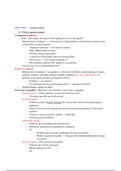Samenvatting
Summary Public Policy and Governance Part 2 (final term)
This document includes in-class notes from lecture 7-14, as well as some notes from the readings (although it is not explicitly mentioned when this is the case). It helped me get a high grade by paying attention to the bold, red and highlighted text. Try to make sure that you understand all the con...
[Meer zien]





